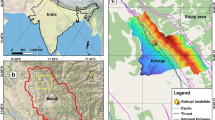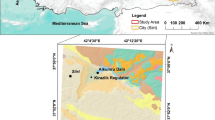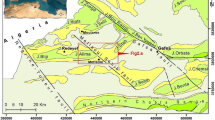Abstract
In this study, we investigated a recent landslide that occurred in Zhouqu County, China. At 18:00 pm Beijing time on July 19, 2019, the Yahuokou landslide was reactivated. About 3.92 × 106 m3 of debris slumped from the slope, blocking the Minjiang River channel, causing the water level to rise, and disrupting road. Fortunately, there were no injuries. A field survey, remote sensing imaging, borehole core analysis, landslide monitoring, and rainfall data analysis were conducted to examine the geomorphologic and stratigraphic characteristics of the landslide, the reactivation causes, and the dynamic mechanism of the landslide. A model for the reactivation and evolution of the landslide is presented. The field survey of the sliding zone indicates that the landslide has a flow-slide deformation pattern. The landslide mechanism is summarized as follows. Initially, slow plastic flow sliding occurred in the upper sliding body. Then the platform in the middle gentle slope was preloaded by deposits from the upper part failure, resulting in a “cutting and filling” effect. The failure occurred in the form of creep–tension cracks–debris flow–slide. Finally, the block on the lower part slumped. Thus, the upper, middle, and lower parts of the landslide all transferred stress in the same manner, being activated step by step, and slowly slumped into the river.











Similar content being viewed by others
References
Bai SB, Wang J, Zhang ZG, Cheng C (2012) Combined landslide susceptibility mapping after Wenchuan earthquake at the Zhouqu segment in the Bailongjiang Basin, China. Catena 99:18–25
Chen HK, Li JJ (1997) General approach on geomorphologic evolution in Bailongjiang basin since Quaternary. J Chongqing Jiaotong Inst 16(1):15–20 (in Chinese with English abstract)
Guo CB, Zhang YS, Li X, Ren SS, Yang ZH, Wu RA, Jin JJ Published online: 23(2019) Reactivation of giant Jiangdingya ancient landslide in Zhouqu County, Gansu Province. China Landslides 17:179–190. https://doi.org/10.1007/s10346-019-01266-9
Liu XW, Yuan DY, Shao YX, Wu Z (2015) Characteristics of late Quaternary tectonic activity in the middle eastern segment of the southern branch of Diebu Bailongjiang Fault, Gansu. J Earth Sci Environ 37(06):111–119 (in Chinese with English abstract)
Ren JZ (1993) The Nanyu landslip and small earthquake activity. NW Seisgeol J 15(2):94–96 (in Chinese with English abstract
Sun Q, Zhang L, Ding XL, Hu J, Li ZW, Zhu JJ (2015) Slope deformation prior to Zhouqu, China landslide from InSAR time series analysis. Remote Sens Environ 156:45–57
Varnes DJ (1978) Slope movement types and processes. In: Schuster RL, Krizek RJ (eds) Landslides, analysis and control, special report 176: Transportation research board. National Academy of Sciences, Washington, pp 11–33
Wang GL (2013) Lessons learned from protective measures associated with the 2010 Zhouqu debris flow disaster in China. Nat Hazards 69:1835–1847
Wang LM, Wu ZJ, Wang P, Chen T (2013) Characteristics, causation, and rehabilitation of Zhouqu extraordinarily serious debris flows in 2010, China. J Cent South Univ 20:2342–2348
Xiao HJ, Luo ZD, Niu QG, Chang J (2013) The 2010 Zhouqu mudflow disaster: possible causes, human contributions, and lessons learned. Nat Hazards 67:611–625
Xie ZT, Chen G, Meng XM, Zhang Y, Qiao L, Tan L (2017) A comparative study of landslide susceptibility mapping using weight of evidence, logistic regression and support vector machine and evaluated by SBAS-InSAR monitoring: Zhouqu to Wudu segment in Bailong River Basin, China. Environ Earth Sci 76:313–319. https://doi.org/10.1007/s12665-017-6640-7
Yuan D, Liu JF, You Y, Liu DC, Sun H, Zhang L, Zhou WB (2018) The siltation of debris flow behind check dam in the midstream of Bailong River. J Mt Sci 15(1):100–113
Zhang X, Yu GQ, Li P, Li ZB (2017) Landslide zoning analysis in Zhouqu under different rainfall warning levels. Environ Earth Sci 76:600–615. https://doi.org/10.1007/s12665-017-6932-y
Zhang Y, Meng XM, Jordan C, Novellino A, Dijkstra T, Chen G (2018) Investigating slow-moving landslides in the Zhouqu region of China using InSAR time series. Landslides 15:1299–1315
Zhao JH (2004) Remote sensing image interpretation of landslide and mud -rock flows in Zhouqu County and disaster prevention. Yangtze River 35(12):1–4 (in Chinese with English abstract)
Acknowledgments
Thanks for some data provided by the Geological and Environmental Monitoring Institute of Gansu Province, China. We thank Dalia Lahav-Jones, from Liwen Bianji, Edanz Group China (www.liwenbianji.cn/ac), for editing the English text of a draft of this manuscript.
Funding
This study was sponsored by the National Natural Science Foundation of China (No. 41902269 and 41702343) and Project of China Geological Survey (DD20190717).
Author information
Authors and Affiliations
Corresponding author
Rights and permissions
About this article
Cite this article
Zhang, Z. Mechanism of the 2019 Yahuokou landslide reactivation in Gansu, China and its causes. Landslides 17, 1429–1440 (2020). https://doi.org/10.1007/s10346-020-01384-9
Received:
Accepted:
Published:
Issue Date:
DOI: https://doi.org/10.1007/s10346-020-01384-9




